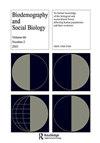印度妇女避孕方法的使用:家庭类型重要吗?
IF 0.9
4区 社会学
Q3 DEMOGRAPHY
引用次数: 3
摘要
摘要避孕方法的使用及其相关性仍然是包括印度在内的发展中国家关注的科学课题,因为它有助于降低生育率和改善妇幼健康。本研究通过分析国家家庭健康调查4(2015-16)的数据,探讨了家庭类型和避孕药具的使用。使用多项式逻辑回归来检验预测变量对避孕药具使用的调整效果。STATA(第13版)用于分析,显著性水平为5%。在调整社会人口和经济特征的影响后,核心家庭的妇女使用现代限制方法的几率比有岳母的非核心家庭的女性低6%(OR=0.94,95%CI=0.92–0.96),使用任何传统避孕方法的几率低5%(OR=0.95,95%CI=0.91–0.99)。家庭类型,尤其是MIL的存在,与儿媳的避孕行为有关。基于最近一项具有全国代表性的调查的结果,有助于现有的关于印度背景下MIL和DIL避孕行为之间关联的证据不足。研究结果表明,公婆对现代间隔方法的好处有了更多的认识,从而提高了其使用率。本文章由计算机程序翻译,如有差异,请以英文原文为准。
Contraceptive method use among women in India: Does the family type matter?
ABSTRACT The use of contraceptive methods and their correlates continues to be a subject of scientific interest in developing countries, including India, for its contribution to reducing fertility and improving maternal and child health. This study explores the family type and contraceptive use by analyzing the National Family Health Survey-4 data (2015–16). Multinomial logistic regression was used to check the adjusted effects of the predictor variables on contraceptive use. STATA (version 13) was used for the analysis with a significance level of 5 per cent. Adjusting the effects of socio-demographic and economic characteristics, women from nuclear family had 6 per cent lower odds of using modern limiting method (OR = 0.94, 95 per cent CI = 0.92–0.96) and 5 per cent lower odds of using any traditional method of contraception (OR = 0.95, 95 per cent CI = 0.91–0.99) than their counterparts from non-nuclear family with mother-in-law (MIL). Family type, especially the presence of MIL, was associated with daughter-in-law’s (DIL) contraceptive behavior. The results based on a nationally representative recent survey contribute to the existing scanty evidence on the association between the MIL and DIL’s contraceptive behavior in the Indian context. Results suggest more awareness about the benefits of modern spacing methods among the mothers-in-law, leading to their enhanced use.
求助全文
通过发布文献求助,成功后即可免费获取论文全文。
去求助
来源期刊

Biodemography and Social Biology
Multiple-
CiteScore
1.50
自引率
0.00%
发文量
14
期刊介绍:
Biodemography and Social Biology is the official journal of The Society for the Study of Social Biology, devoted to furthering the discussion, advancement, and dissemination of knowledge about biological and sociocultural forces affecting the structure and composition of human populations. This interdisciplinary publication features contributions from scholars in the fields of sociology, demography, psychology, anthropology, biology, genetics, criminal justice, and others. Original manuscripts that further knowledge in the area of social biology are welcome, along with brief reports, review articles, and book reviews.
 求助内容:
求助内容: 应助结果提醒方式:
应助结果提醒方式:


